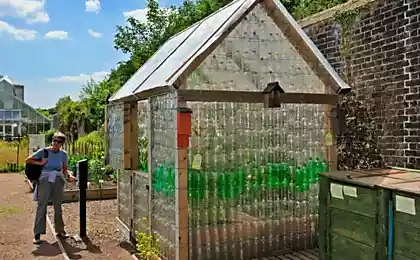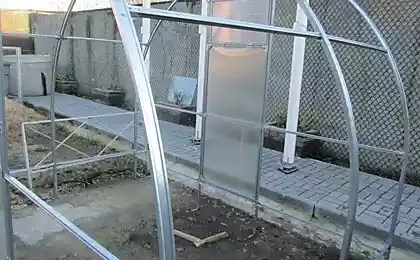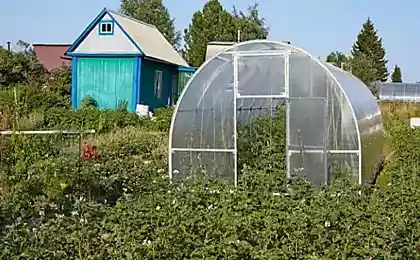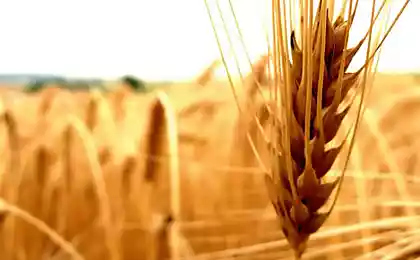147
Preparation of the greenhouse for spring plantings
Last year, I became a happy owner of a polycarbonate greenhouse - my husband made it with his own hands. It so happened that the greenhouse was collected in late autumn, so I did not have time to grow anything in it. Spring came, and with it the need to prepare the greenhouse for planting. How to do this, I had no idea, so I had to seek help from familiar gardeners and study literature on the topic.
As a result, this is the list of spring work in the greenhouse:
In order for plants to receive enough light, it is advisable to wash the film coating outside and inside. Internal walls, ceiling and frame need to be disinfected (how and how it can be done, read below). Some for the winter remove the film from the frame; in this case, they are treated separately, and then fasten the clean film on a clean frame.
Greenhouses coated with polycarbonate and glass
These materials are stronger than film, but during the winter they can get damaged. If they are found - eliminate, if not - you can take for washing and disinfection.
Disinfection of the greenhouse - what do we process? So we got to the most difficult (in my opinion) topic. Honestly, the head goes around: what method of processing to choose? I want to protect plants from possible diseases and pests, but not at the expense of the quality of products. How do you find the middle ground?
Sulfur checkers.For 1 cubic meter of room you need 50 grams of sulfur, if there were few pests last year. And if a lot, then the dose is increased to 150 g. In our village this is the most popular means of disinfecting greenhouses, which I think is a little strange. According to the reviews of gardeners using sulfur checkers, they do not save from phytophthora, bacteriosis and false powdery dew. Embarrassing is the fact that sulfur dioxide, formed during the combustion of sulfur bombs, in huge quantities will get into the soil. In the greenhouse, it is not spilly, and eventually everything will be in greens and vegetables.
A solution of slurry.For 10 liters of water you need 3 kg of slurry lime and 500 grams of copper sulfur. Process the resulting solution of the frame and the surface of the ceiling and walls.
Use of biologics.In my opinion, this is the only correct direction in crop production. For example, the drug "Fitop-Flora-C" will not only relieve plants from fungal diseases, but also suppress the growth of pathogenic microflora in the future. To treat the greenhouse, you will need a working solution: 100 g of the drug per 10 liters of water. Attention! Water should not contain chlorine! On 30 square meters of the surface of the greenhouse, 10 liters of working solution will be required. After 2 weeks, the processing will need to be repeated.
Increasing soil fertility. In a greenhouse, we usually plant the same crops from year to year, so the soil here requires more attention than in conventional garden beds. What options for its recovery, enrichment with nutrients are offered?
Replace the top layer of soil.Experts recommend replacing the top layer of greenhouse soil every year, removing 10-20 cm. Instead, they sprinkle purchased soil for seedlings or prepare a soil mixture themselves. For greenhouse beds mixed sod soil, river sand, humus and peat (1:1:3:5). To neutralize the acid reaction of peat, 3 kg of lime are added to 1 cubic meter of the mixture. This is probably the most time-consuming and expensive way, definitely not for me.
Sowing siderates
No one argues about the benefits of ciderates, so you can safely sow rye, oats, vica, mustard, facelia, watercress on greenhouse beds. In order not to miss precious time, during the fruiting period of crops planted in the greenhouse, siderates can be sown in between rows, and in autumn, sow the harvested ridges with winter rye or oats.
Use of EM drugs
They will help protect plants from diseases and pests, get a richer and (importantly) environmentally friendly crop. At the same time, they will populate the soil with useful microorganisms, healing it and improving the structure.
Biofuel ridges
They can be done both in the open air and in the greenhouse. About what types of "warm" beds are, how to make them, what and when to plant, detailed in this article. If you are interested in the topic of biofuel beds, read it.
Source: www.7dach.ru
As a result, this is the list of spring work in the greenhouse:
- cleaning and repair;
- disinfection of the greenhouse and soil (if not replaced);
- Increase soil fertility.
- Spring cleaning and repair in the greenhouse
- With cleaning, everything is clear – remove the remains of last year’s crops and weeds. Everything that served as a temporary support (pegs, strings for tying) will also have to be removed or disinfected.
- Film-coated greenhouses
In order for plants to receive enough light, it is advisable to wash the film coating outside and inside. Internal walls, ceiling and frame need to be disinfected (how and how it can be done, read below). Some for the winter remove the film from the frame; in this case, they are treated separately, and then fasten the clean film on a clean frame.
Greenhouses coated with polycarbonate and glass
These materials are stronger than film, but during the winter they can get damaged. If they are found - eliminate, if not - you can take for washing and disinfection.
Disinfection of the greenhouse - what do we process? So we got to the most difficult (in my opinion) topic. Honestly, the head goes around: what method of processing to choose? I want to protect plants from possible diseases and pests, but not at the expense of the quality of products. How do you find the middle ground?
Sulfur checkers.For 1 cubic meter of room you need 50 grams of sulfur, if there were few pests last year. And if a lot, then the dose is increased to 150 g. In our village this is the most popular means of disinfecting greenhouses, which I think is a little strange. According to the reviews of gardeners using sulfur checkers, they do not save from phytophthora, bacteriosis and false powdery dew. Embarrassing is the fact that sulfur dioxide, formed during the combustion of sulfur bombs, in huge quantities will get into the soil. In the greenhouse, it is not spilly, and eventually everything will be in greens and vegetables.
A solution of slurry.For 10 liters of water you need 3 kg of slurry lime and 500 grams of copper sulfur. Process the resulting solution of the frame and the surface of the ceiling and walls.
Use of biologics.In my opinion, this is the only correct direction in crop production. For example, the drug "Fitop-Flora-C" will not only relieve plants from fungal diseases, but also suppress the growth of pathogenic microflora in the future. To treat the greenhouse, you will need a working solution: 100 g of the drug per 10 liters of water. Attention! Water should not contain chlorine! On 30 square meters of the surface of the greenhouse, 10 liters of working solution will be required. After 2 weeks, the processing will need to be repeated.
Increasing soil fertility. In a greenhouse, we usually plant the same crops from year to year, so the soil here requires more attention than in conventional garden beds. What options for its recovery, enrichment with nutrients are offered?
Replace the top layer of soil.Experts recommend replacing the top layer of greenhouse soil every year, removing 10-20 cm. Instead, they sprinkle purchased soil for seedlings or prepare a soil mixture themselves. For greenhouse beds mixed sod soil, river sand, humus and peat (1:1:3:5). To neutralize the acid reaction of peat, 3 kg of lime are added to 1 cubic meter of the mixture. This is probably the most time-consuming and expensive way, definitely not for me.
Sowing siderates
No one argues about the benefits of ciderates, so you can safely sow rye, oats, vica, mustard, facelia, watercress on greenhouse beds. In order not to miss precious time, during the fruiting period of crops planted in the greenhouse, siderates can be sown in between rows, and in autumn, sow the harvested ridges with winter rye or oats.
Use of EM drugs
They will help protect plants from diseases and pests, get a richer and (importantly) environmentally friendly crop. At the same time, they will populate the soil with useful microorganisms, healing it and improving the structure.
Biofuel ridges
They can be done both in the open air and in the greenhouse. About what types of "warm" beds are, how to make them, what and when to plant, detailed in this article. If you are interested in the topic of biofuel beds, read it.
Source: www.7dach.ru
The young architect started building the first energy efficient house in the CBD
Mastery of disguise in the garden























